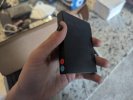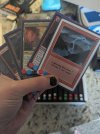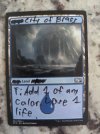Hello, here is my promised big jumpstart cube post. I do not claim to be an expert on jumpstart cube, but I have built one and I have thought about it a lot, and I thought it would be fun to get the ball rolling on talking about this subformat a little more.
You can check out my current jumpstart cube list here:
https://cubecobra.com/cube/overview/pushstart
I'm not 100% satisfied with this list because no one ever is with any list, but it is extremely fun to play.
Reasons to Build Jumpstart Cubes
1. They're fast and convenient compared to traditional cubes. If a traditional cube is an 8-player draft in a box, a jumpstart cube is a quick fun game of Magic in a box.
2. They're great for playing with beginners and casual players. Deckbuilding is hard, maybe the hardest part of the game for new players, and jumpstart removes that barrier to entry in the same way that precons do. I prefer jumpstart to battlebox for this type of thing, because jumpstart doesn't have any special weird land rules and just works like how Magic works.
3. They give the designer a ton of control over the environment. Being able to dictate exactly which cards get played allows you to design the type of gameplay you'd like to see with a higher degree of control than with a draft environment.
4. They're challenging to design. Because of the last point, every slot in a jumpstart cube really counts. You can't rely on "well if it sucks people will just sideboard it". This makes the stakes feel very high when you test with your friends lol.
5. They have a lot of underexplored potential. Designing your own jumpstart cube doesn't seem to be nearly as popular as just building set cubes of WOTC's jumpstart sets. I've been having fun with it, but I'm a real meat and potatoes kinda cube designer, I like building simple fun environments with cards people know. I would love to see what some of the avant garde cube sickos on here could come up with.
6. People just love them. Of all the things I've designed, I think people have responded the most positively to Pushstart. I get asked to bring it out all the time. I've brought it to parties and music festivals and shit and people get stoked on it. I have friends who otherwise don't like playing Magic who love that cube. Sometimes I get in my head about like oh I don't like the way the Simic half-deck is balanced right now the cube is probably bad and then I watch people play it and I'm like oh right this cube kicks ass.
Getting Started
Have to start here by shouting out The Ultimate Guide to Jumpstart Cube, which was basically the only primer that existed when I started working on Pushstart.
I don't want to just repeat what this guide already says so well, so here is what I suggest that you actually do to get started on a jumpstart cube:
1. Read the guide linked above, it has a lot of good advice
2. Every time michael921 cautions against doing something that you think would be sick actually, say to yourself "no but I'm different".
3. Make a spreadsheet that looks something like this:

4. Every time you think "oh you know what card would be cool in the monored one" while you are supposed to be doing your stupid job, add it to the spreadsheet.
5. You are now invested enough that you will care enough to finish filling out the spreadsheet. I recommend starting with like 5-10 half-decks and working your way up as you get more comfortable with the cube.
6. Drink at least 1-2 twisted teas on a week night and order cards/print proxies.
7. Hang out with your friends and play the cube
8. Get excited about how fun it is but also frustrated with some obviously bad initial decisions you made, revise and repeat, you guys all know this part
Challenges
1. Mana Fixing - Obviously you need rainbow lands to make these things work. WOTC jumpstart packs use the thriving lands for their fixing and only give you one and you could do that I guess.
I've been going with Prismatic Vistas and then some City of Brasses for the multicolor packs, and that's been working pretty well. My plan is to eventually just proxy up a "super fetch" that can just fetch any land with a basic land type, and just replace all the City of Brasses and Prismatic Vistas with those and some shocks/duals.
I think you shouldn't be afraid to be adventurous with these, it's fine if your fixing is really busted since the format is so self-contained and everyone gets to have it. I don't think playing a no-downside City of Brass would be an insane idea.
2. Multicolor Packs - michael921 says you shouldn't do these at all but I'm different of course. What are you gonna do, not play Baleful Strix? I generally tell people to pick 2 packs of up to 3 colors so they don't end up in 4 color nonsense, but I think you could build a cube where the 4 color decks are functional if you're willing to just make the mana bases insanely good.
The biggest challenge I've had with these besides fixing is getting the mana curves right. Multicolor cards gotta cost at least 2, so it can be hard to include all the ones you want if your format is really fast.
3. Mana Curves - I recommend setting some sort of cap on mana value and not having cards that are more expensive than that (outside of like, a ramp deck). Then let that dictate the rest of the mana curve. I don't think you have to overthink this too much. Just like traditional cube, when in doubt, just play cheap cards and mana sinks. My packs are mostly 1s and 2s with a couple 3s or 4s.
4. Combos and Synergy - I've found that straight up A+B+C combo decks are pretty hard to make work. I was trying to make my Golgari deck do some stupid reanimator stuff, but the nature of jumpstart just makes it really hard for something like that to come together. Someone who has more of a mind for this kind of thing could probably make it happen, but I think the cube would need to be built from the ground up to support it. For most designs, I think emphasizing mostly self-contained cards with synergy hooks is the easiest way to make packs bounce off each other in novel ways.
5. Slot Efficiency - The decision paralysis when designing these things is insane lmao. The 12ish nonland slots that you have to work with feels so suffocating sometimes. People always talk about how "every slot counts" in traditional cube, but you can always just make a traditional cube have 361 cards and it won't kill you. With jumpstart you will be agonizing over "slots" regardless of how much of a spreadsheet aesthetics rebel you usually are.
6. Balance - Same as it ever was. I think balancing jumpstart cube can feel a little more daunting sometimes, because it does not have the self-correcting nature of draft. But it is also much easier to iterate on since you can just, play the pack that you changed and see if it's doing better now.
Overall I try not to worry too much about balance. There's no possible way to account for all of the different combinations of packs in the cube and how they match up against each other. I am instead looking to have packs that play well with all or most of the other packs, feel consistently functional and fun to play, and do cool stuff.
Logistics
I could do a whole write up trying to explain all of the logistical problems with organizing these things in paper, but I think these three images show the problem and my solution better than I could with words:



(don't make fun of my nails I do them like that on purpose)
I know this is a good solution because people who have never played the cube before immediately understand how to sort their cards when they're done playing without even having to ask me, which is exactly what I want to happen. The cube packs are Dragon Shield Cube Shells. The stickers I just got on Etsy.
Only real problems with this solution are:
1. You gotta put stickers on all the cards. Mine are all proxies or cheap so I don't care, but I understand this is sacrilege to some people. Put some paper in there I guess.
2. Not accessible for people who are colorblind. I'm probably gonna just get a silver marker and write the names of the colors on the packs because of this.
3. It's a little plain. I like the minimalist look of it, but if you wanted to give all of them cool custom names and fancy custom stickers I think that would be badass.
I haven't gone this route for this project, but I think it would also be pretty reasonable to take a "bar cube" approach to a jumpstart cube and try to eliminate tokens, counters, shuffling, etc. so you can make it even more portable.
Thanks for reading!
I would love to hear what ideas folks on here have for novel jumpstart cubes!
You can check out my current jumpstart cube list here:
https://cubecobra.com/cube/overview/pushstart
I'm not 100% satisfied with this list because no one ever is with any list, but it is extremely fun to play.
Reasons to Build Jumpstart Cubes
1. They're fast and convenient compared to traditional cubes. If a traditional cube is an 8-player draft in a box, a jumpstart cube is a quick fun game of Magic in a box.
2. They're great for playing with beginners and casual players. Deckbuilding is hard, maybe the hardest part of the game for new players, and jumpstart removes that barrier to entry in the same way that precons do. I prefer jumpstart to battlebox for this type of thing, because jumpstart doesn't have any special weird land rules and just works like how Magic works.
3. They give the designer a ton of control over the environment. Being able to dictate exactly which cards get played allows you to design the type of gameplay you'd like to see with a higher degree of control than with a draft environment.
4. They're challenging to design. Because of the last point, every slot in a jumpstart cube really counts. You can't rely on "well if it sucks people will just sideboard it". This makes the stakes feel very high when you test with your friends lol.
5. They have a lot of underexplored potential. Designing your own jumpstart cube doesn't seem to be nearly as popular as just building set cubes of WOTC's jumpstart sets. I've been having fun with it, but I'm a real meat and potatoes kinda cube designer, I like building simple fun environments with cards people know. I would love to see what some of the avant garde cube sickos on here could come up with.
6. People just love them. Of all the things I've designed, I think people have responded the most positively to Pushstart. I get asked to bring it out all the time. I've brought it to parties and music festivals and shit and people get stoked on it. I have friends who otherwise don't like playing Magic who love that cube. Sometimes I get in my head about like oh I don't like the way the Simic half-deck is balanced right now the cube is probably bad and then I watch people play it and I'm like oh right this cube kicks ass.
Getting Started
Have to start here by shouting out The Ultimate Guide to Jumpstart Cube, which was basically the only primer that existed when I started working on Pushstart.
I don't want to just repeat what this guide already says so well, so here is what I suggest that you actually do to get started on a jumpstart cube:
1. Read the guide linked above, it has a lot of good advice
2. Every time michael921 cautions against doing something that you think would be sick actually, say to yourself "no but I'm different".
3. Make a spreadsheet that looks something like this:

4. Every time you think "oh you know what card would be cool in the monored one" while you are supposed to be doing your stupid job, add it to the spreadsheet.
5. You are now invested enough that you will care enough to finish filling out the spreadsheet. I recommend starting with like 5-10 half-decks and working your way up as you get more comfortable with the cube.
6. Drink at least 1-2 twisted teas on a week night and order cards/print proxies.
7. Hang out with your friends and play the cube
8. Get excited about how fun it is but also frustrated with some obviously bad initial decisions you made, revise and repeat, you guys all know this part
Challenges
1. Mana Fixing - Obviously you need rainbow lands to make these things work. WOTC jumpstart packs use the thriving lands for their fixing and only give you one and you could do that I guess.
I've been going with Prismatic Vistas and then some City of Brasses for the multicolor packs, and that's been working pretty well. My plan is to eventually just proxy up a "super fetch" that can just fetch any land with a basic land type, and just replace all the City of Brasses and Prismatic Vistas with those and some shocks/duals.
I think you shouldn't be afraid to be adventurous with these, it's fine if your fixing is really busted since the format is so self-contained and everyone gets to have it. I don't think playing a no-downside City of Brass would be an insane idea.
2. Multicolor Packs - michael921 says you shouldn't do these at all but I'm different of course. What are you gonna do, not play Baleful Strix? I generally tell people to pick 2 packs of up to 3 colors so they don't end up in 4 color nonsense, but I think you could build a cube where the 4 color decks are functional if you're willing to just make the mana bases insanely good.
The biggest challenge I've had with these besides fixing is getting the mana curves right. Multicolor cards gotta cost at least 2, so it can be hard to include all the ones you want if your format is really fast.
3. Mana Curves - I recommend setting some sort of cap on mana value and not having cards that are more expensive than that (outside of like, a ramp deck). Then let that dictate the rest of the mana curve. I don't think you have to overthink this too much. Just like traditional cube, when in doubt, just play cheap cards and mana sinks. My packs are mostly 1s and 2s with a couple 3s or 4s.
4. Combos and Synergy - I've found that straight up A+B+C combo decks are pretty hard to make work. I was trying to make my Golgari deck do some stupid reanimator stuff, but the nature of jumpstart just makes it really hard for something like that to come together. Someone who has more of a mind for this kind of thing could probably make it happen, but I think the cube would need to be built from the ground up to support it. For most designs, I think emphasizing mostly self-contained cards with synergy hooks is the easiest way to make packs bounce off each other in novel ways.
5. Slot Efficiency - The decision paralysis when designing these things is insane lmao. The 12ish nonland slots that you have to work with feels so suffocating sometimes. People always talk about how "every slot counts" in traditional cube, but you can always just make a traditional cube have 361 cards and it won't kill you. With jumpstart you will be agonizing over "slots" regardless of how much of a spreadsheet aesthetics rebel you usually are.
6. Balance - Same as it ever was. I think balancing jumpstart cube can feel a little more daunting sometimes, because it does not have the self-correcting nature of draft. But it is also much easier to iterate on since you can just, play the pack that you changed and see if it's doing better now.
Overall I try not to worry too much about balance. There's no possible way to account for all of the different combinations of packs in the cube and how they match up against each other. I am instead looking to have packs that play well with all or most of the other packs, feel consistently functional and fun to play, and do cool stuff.
Logistics
I could do a whole write up trying to explain all of the logistical problems with organizing these things in paper, but I think these three images show the problem and my solution better than I could with words:



(don't make fun of my nails I do them like that on purpose)
I know this is a good solution because people who have never played the cube before immediately understand how to sort their cards when they're done playing without even having to ask me, which is exactly what I want to happen. The cube packs are Dragon Shield Cube Shells. The stickers I just got on Etsy.
Only real problems with this solution are:
1. You gotta put stickers on all the cards. Mine are all proxies or cheap so I don't care, but I understand this is sacrilege to some people. Put some paper in there I guess.
2. Not accessible for people who are colorblind. I'm probably gonna just get a silver marker and write the names of the colors on the packs because of this.
3. It's a little plain. I like the minimalist look of it, but if you wanted to give all of them cool custom names and fancy custom stickers I think that would be badass.
I haven't gone this route for this project, but I think it would also be pretty reasonable to take a "bar cube" approach to a jumpstart cube and try to eliminate tokens, counters, shuffling, etc. so you can make it even more portable.
Thanks for reading!
I would love to hear what ideas folks on here have for novel jumpstart cubes!
Last edited:


 based around
based around 

